While many rose growers consider the rose to be “Queen of the Garden,” roses don’t bloom constantly and many are kind of bare at the bottom. Here in the high desert, they lose their leaves in the winter. So, many rose gardens look better with some other plants growing with the roses. Here are some that work well in the Albuquerque area.
Pansies and Roses
Pansies do extremely well in the high desert of the Southwest, providing color through the fall, then reblooming again in early spring until the temperatures get too hot. By that time, the roses are blooming. Pansies are technically perennials, but are grown as annuals in this region.
Bulbs and Roses
Spring-flowering bulbs such as crocus, daffodils, and narcissus bloom earlier than roses, and can also add color to the garden long before the roses are ready to bloom. These need to be planted in the fall for spring bloom.
This photo was taken March 14, 2005. The daffodils are blooming, but a late snow is falling. So it goes in the high desert of the Southwest.
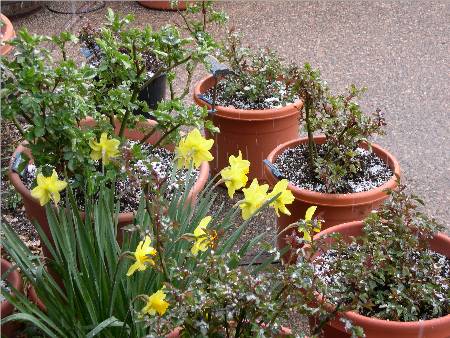
Clematis and Roses
Clematis can be a fabulous companion plant for climbing roses. The rose provides support on which the clematis can climb, and the rose also provides shade for the roots of the clematis. Clematis is picky in that it likes cool roots, with lots of sun on the leaves. Combining clematis with a climbing rose is perfect. My personal favorite is the white clematis, Henryi, because it is tough and the color goes with everything. This is Henryi growing with Mermaid. The clematis blooms several weeks before the rose, and again late in sumer before the rose blooms in the fall. The perfect companion, in my opinion.
Companion Plants That Bloom at the Same Time as Roses
This photo shows Mermaid climbing up the outside wall of the fireplace. At the base in a pot is an Autumn Sage that is just beginning to bloom. These grow extremely well in the high desert, and attract humming birds.
The yellow flowers in front are coreopsis. These flowers grow well and are self-seeding. The only drawback is that you must cut off the old blooms or the plants look really terrible. But if you do keep the old blooms cut, the plant will bloom all summer.
The large green leaves belong to canna lilies, which tend to bloom later in the summer when not much else is blooming. Canna lilies are also great for attracting hummingbirds.
The photo of this hummer was taken at a feeder, but they seem to prefer certain flowers, such as those mentioned above, over the feeders.

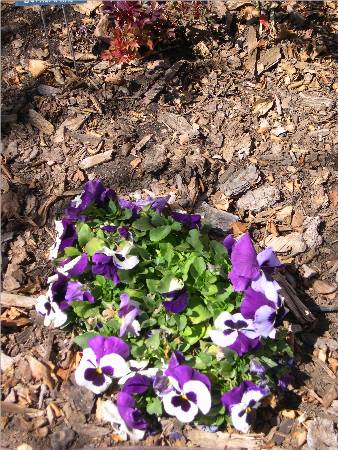
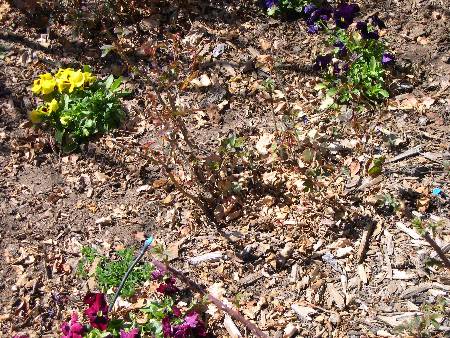
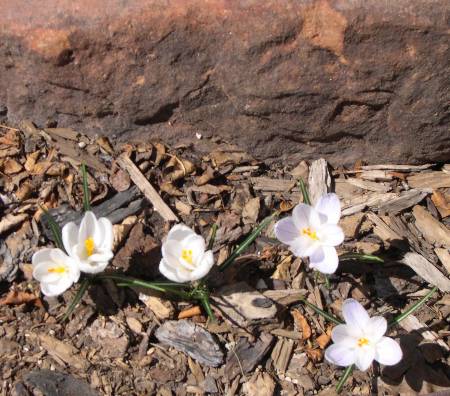
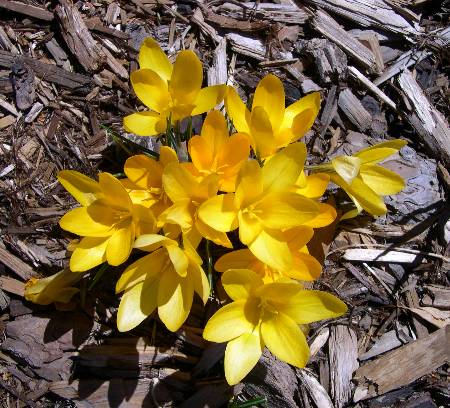
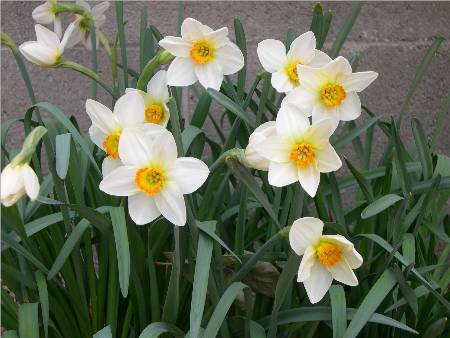
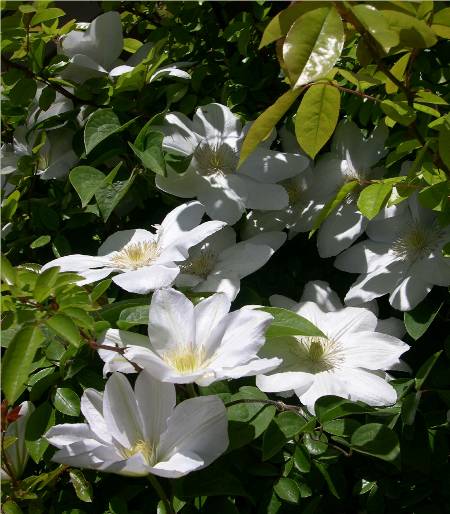
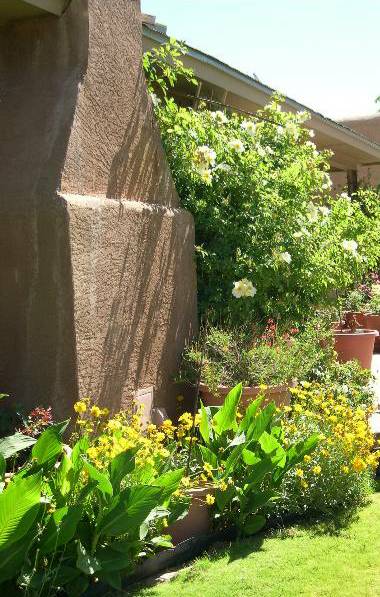
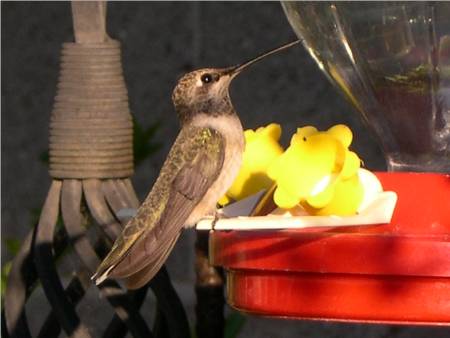


I like the dwarf coreopsis that blew in some years ago and now puts on a show, only requiring the pinching periodically and the yellow golden color is a pretty bouquet at the base of our live oak that hangs over our front yard where several years ago I replaced the water wasting St. Augustine grass with a mix of trailing white and pinkish lantana and blue purple Mexican petunias. These are great zone appropriate plants for the hot weather and drought conditions in South Texas. In the spring I like to buy a bag of Texas wildflower seeds and sprinkle them over the front yard and then water enough that they get a good start and fill the lawn with a wide range of wildflower shapes and colors and coax them along till the summer heat. We have butterflies and moths and the deer who come up from the natural trail and the deer park don’t enjoy either of the two major Texas plants, lantana and Mexican petunias and even the coreopsis doesn’t appear palatable for deer. So, we’ve saved water and money on the front and I like the thickness of the lush carpet of lantana because I get to express my deeper desire of letting front yards put on a baroque show instead of military squared grass worship. My protest against the military rigidity and weekend torture I knew growing up edging slanted bricks on my Saturdays! My anti-authoritarian nature has caused several “letters of concern” from the HOA fascists but I get lots of compliments when the whole orchestral blooming goes over the top in spring and early summer. There you have it…One year I went undercover and scattered the backyard (beyond the eyes of the HOA) with wildflower seeds and let the yard fill with all sorts of wild plans blowing in during the spring and I didn’t cut them almost all summer and the backyard was a total party all summer for bees, and every sort of insects like dragonflies and Henry the outside cat had fun creeping through the wilderness and incredible weeds came up with all sorts of beetles and flying insects and I somehow managed to get away with this brazen rejection of all formal restraints until Laurie threatened hire a landscaper to cut it all back. I love the chaos of weeds, flowers and volunteers. This has been partly inspired by the New England traditions of wildflower front yards inside white picket fences which is a bit more sedate and controlled and managed within Shaker and Pilgrim like neatness and simplicity. Thanks for sharing your backyard and the mutual support between the rose and clematis. Okay, beautiful flower color photography; definitely picks me up…I understand your love of flowers. I grew up around naturally trained southerners who make their livings off plants of one sort or another. My mother loved flowers and arranging and she had quite an elaborate vocabulary. When she visited us in Boston I took her for a walk in Harvard’s Arboretum and she was in heaven and amazed Laurie with her knowledge of names, popular and technical. My mother loved walking yards with relatives with phenomenal knowledge of plants and flowers. Being a “guy” I was only slightly engaged with the conversational displays of words and subtle observations. But this was a tradition of plant knowledge passed down through families in South Georgia where conditions are right for maximum growing opportunities. Just about everyone I knew who stayed in the region makes a living through the plant businesses of one sort or another. I have a female cousin who has made a name for herself with a plant shop in the local town and county seat and a lucrative landscaping business. She inherited seemingly all the family tree’s “gifts” for botanical insight and recall. Well, I’m nipping this riff in the bud right now…
Hi, Jim. I just now came across this, so I apologize for taking so long to respond! It is a good read; thank you! I remember one of your images of the wildflowers in the back yard, with the bird bath. A long time ago I bought one coreopsis plant, and it has reseeded itself throughout the back yard. Cosmos that I planted from seed a couple of years ago is doing pretty well at naturalizing a portion of the yard. Hummingbirds, goldfinches, house finches, butterflies, bees, dragonflies, all sort of things love the cosmos, and it seems to thrive here in our desert. Some time ago I started getting sunflower volunteers from the birds. I liked them, so I started planting a few more exotic ones for photography. My yard looks a lot different now than it did when those images were made, and I think most of those were made with a little Nikon Coolpix. I know the one of ‘Mermaid’ was done in 2006, because it has just now reached that size again after being almost totally destroyed by a 22″ snowfall in December of 2006.
I don’t have lantana, but that is a plant I ought to consider here. I’ve always liked it, and grew it in Arizona. I’m sure it looks great in your yard.
My mom always kept a perfect yard, lots of flowers, etc., and my dad kept a perfect lawn. My son in Texas doesn’t grow flowers as such, but he is very particular about the trees and bushes in his yard. My mom finally has some help with her yard (very small, still beautiful), but it took her until she was 90 to allow any help!
/ramble
Anyway, thank you for dropping by, and writing such a personal comment. I enjoyed hearing from you on this topic, which I’m pretty sure is the first time… 🙂